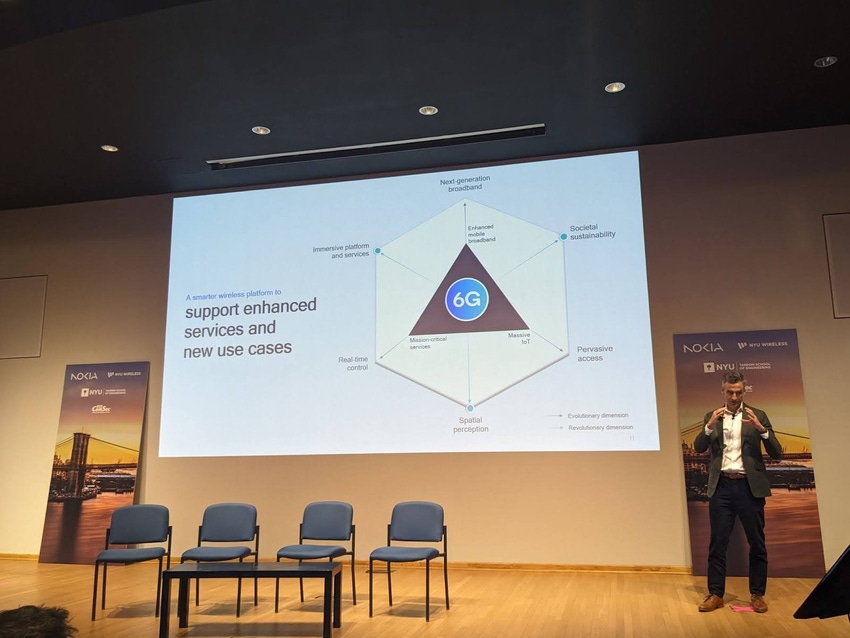6G Summit brings unusual plea from carriers: Slow your roll
A recent 6G conference in New York saw enthusiasm from researchers and trade groups that was not matched among big US telecom network operators.

NEW YORK – BROOKLYN 6G SUMMIT – On the first day of a conference meant to serve up 6G's possibilities, cold water followed a coffee break.
"We're getting a little bit worn out with the economics of the industry," AT&T technology EVP Chris Sambar said in a keynote last week at the Brooklyn 6G Summit. He contrasted a cost of $6 to $8 billion to put one spectrum band into service on towers nationwide with carrier uncertainty over 6G's return on investment.
"The capital investments, they have to be logical," he said in an echo of earlier expressions of 6G-capex angst. "We have to have clear line of sight to the consumer use cases."
Adding that AT&T had spent more than $40 billion on midband spectrum, Sambar said the company did not want to keep seeing similar figures land on its balance sheets: "It can't be a bottomless-pit industry."
After saying that carriers are "counting on all of you to help us figure out" 6G's business use cases, he threw out his own guess: "The most likely use cases in the consumer world are extended reality, the metaverse."
But the extended reality example he threw out – using goggles for outdoor training of soldiers – was nowhere near consumer grade.
A day later, Princeton University dean of engineering and applied science Andrea Goldsmith argued that with 5G already not living up to early sales pitches, a 6G business case needed grounding in consumer reality: "What are we going to do to enable new applications that people will actually pay for?"
Metaverse wishcasting
6G Summit speakers offered various answers to that question. The least specific came from Mediatek communication-system-design general manager Mingxi Fan, who offered a Field of Dreams-esque prediction in a keynote: "Once you build the roads, there will be applications that run on top."
Many more specific ones relied on equally optimistic forecasts for metaverse adoption, at least among business customers.
"The pull that we're seeing is really enterprise," said Hemanth Sampath, an engineering VP at Qualcomm, on a panel devoted to metaverse prospects. Michael Höök, a radio-research area director at Ericsson, joined that endorsement, commending extended reality's "obvious benefits in the industrial applications and on the enterprise side."
That panel exhibited less confidence than other speakers in XR's consumer applications. For instance, Qualcomm senior technology director Ozge Koymen predicted that "outdoor AR use cases will be big in 6G" in a keynote.
Neil Trevett, vice president of developer ecosystems at Nvidia and president of the Metaverse Standards Forum, waved off too-early optimism about how thin and light AR glasses might get.
"Everyone with an interest in XR needs to be careful to set expectations," he warned.
The metaverse discussion closed with moderator Thierry Klein, Nokia's president of Bell Labs Solutions Research, asking panelists for odds that this summit's 2033 edition would happen only in the metaverse. Sentiment varied between "nope" and "maybe." Höök drew applause as he offered a 0% prediction and said, "We need to meet, we need to go to dinner."
A GlobalData study released last week offered more reasons for skepticism about consumer XR adoption. It speculated that enterprise adoption would fuel most of a predicted growth in global metaverse revenue from $48 billion in 2022 to $400 billion in 2030.
If not face-mounted computers, what else will drive 6G adoption? In his keynote, Qualcomm's Koymen urged people "to look at an array of capabilities" that included digital-twin modeling of real-world things, unspecified "human augmentation" and holographic telepresence.
Attendees got a second helping of futuristic forecasts in a keynote from Takki Yu, a vice president at SK Telecom who heads its Infra Tech Office. In addition to plugging the metaverse, this presentation suggested autonomous mobility, drones and 8K video would also boost 6G adoption and allow SKT "to enable our customers to create a new life by expanding time and space."
Efficiency may be easier to sell
The less hand-wavey argument for 6G involved its potential to transmit bits more efficiently, somewhat as 5G delivered spectral-efficiency improvements over LTE.
Elsewhere in his keynote, Qualcomm's Koymen said that designers of 6G's air interface should strive for a 50% boost in link performance and two to three times better capacity from cloud-based RAN. He also said 6G's key performance indicators (KPIs) should encompass network energy efficiency, another increasingly common pitch for 6G.
A Nokia Bell Labs table in the summit's exhibit area suggested the potential of these process-level improvements, displaying how using machine-learning algorithms to fine-tune reception on a 3.5GHz signal yielded 28% throughput gains on a 120 kph train in tests.
The same presentation revealed that applying some of these techniques in the same test to 5G Advanced delivered a 17% throughput gain, suggesting performance improvements from lower overhead in the 6G protocol were not vaporous.
AT&T's Sambar sounded most optimistic about 6G when he nodded to its potential to deliver AI-enhanced, self-optimizing networks, saying "a machine to manage that" would be a terrific scenario. Especially if it could ensure priority service for the carrier's best customers.
Spectrum shortfall
The summit's 6G evangelism seemed most evanescent when speakers discussed what spectrum might be lit up with 6G first. Regulators have done creative work in freeing up spectrum for 5G, but that leaves little to no greenfield spectrum open for any new G.
A presentation by Michael Ha, chief of policy at the FCC's Office of Engineering and Technology, didn't name any bands that the commission was considering earmarking for 6G use – probably because carriers are still clamoring for more spectrum for 5G.
And while the wireless industry has grown increasingly focused on the 6G potential for spectrum between 7 and 15GHz, Ha only cited the "lightly used" 12.7-13.25GHz band – eyed by Samsung for 6G use – that could be refarmed to free up 525MHz of mobile bandwidth.
"We think 6G needs integrated and dynamic spectrum sharing by design," NTIA deputy associate administrator for spectrum planning and policy Derek Khlopin said in the next presentation. He advised tempering expectations: "Bandwidth, coverage, cost; you can pick two."
The summit featured less enthusiasm about terahertz bands than prior 6G gatherings, and one exhibit showed why: a tabletop setup from Northeastern University's Institute for the Wireless Internet of Things delivered 32 Gbit/s throughput from 130GHz radios, but only from about a yard away.
Multiple 6G speakers endorsed how this standard promises to support seamless interoperability between terrestrial and satellite networks. But Ha advised that it will be even more important to avoid fragmentation there: "On the satellite side, it really, truly needs to be a single band."
Lots of runway left for 5G
A surprising number of 6G Summit speakers used their time on stage to tout the potential of 5G, in particular the 5G Advanced version coming with 3GPP Release 18 next year.
For example, the head of a group set up to advance next-G services declared 5G too early to grade yet. "It's still in kindergarten," said Colin Wilcock, chair of the 6G Smart Networks and Services Industry Association.
"It's an awesome technology and it's translated to so much value," said T-Mobile SVP of technology development and strategy Karri Kuoppamaki on the same panel. For instance, the carrier is only now starting to deploy network-slicing services.
In another keynote, Reliance Jio mobility CTO Shyam Mardikar updated the audience on that Indian carrier's breakneck 5G buildout – which has seen more than a million 5G cell sites go live in 12 months, leading to an expected 100x increase in data consumption.
And because this network has been built on standalone 5G, Mardikar noted that Jio is already offering network slicing and network-based positioning, allowing it to provide digital-twin services for building developers.
A final 6G reality check came from one of the summit's last speakers, Technical University Dresden professor and chair Frank Fitzek. He asked for a show of hands from people who wanted to use a 6G network (close to half) and then how much would be willing to pay extra for it (far fewer). And then he threw out a reminder that even 5G isn't an automatic upgrade for customers looking for wireless connectivity.
"Never forget Wi-Fi," he said. "They have something that 5G will never have: lower cost."
About the Author(s)
You May Also Like




_International_Software_Products.jpeg?width=300&auto=webp&quality=80&disable=upscale)







